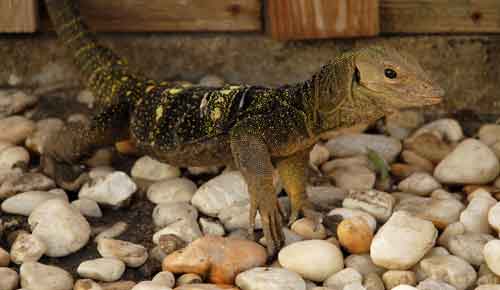Description:
These monitor lizards require a somewhat roomy area with a large water area. For a subadult or adult I recommend a terrarium, Vision Cage or similar manufactured enclosure measuring about 5 to 6 feet long and 3 feet deep. These monitors do enjoy a good climb, so the taller the better; an enclosure that’s at least 2 feet tall is a must. Add a few extra square feet to any enclosure if you plan on housing a pair. Use cypress or coconut coir for the substrate, or a mix of either of these with organic potting soil. A large container of water should be provided. This can take up as much as a third of the floor space in the enclosure. Make it about 6 inches deep (or deeper), so the monitor can fully submerge and at least simulate swimming. Add elevated branches and basking areas, and on the far end from the water provide a hide large enough to cover all cage occupants. Plastic hides, cork rounds or wooden hides can all work well. Provide two heat lamps or emitters. I recommend one incandescent heat lamp to create a basking hot spot of about 95 degrees Fahrenheit. The ambient enclosure temperature can be maintained at about 85 degrees. Use either a nocturnal basking lamp or heat emitter to create a nighttime hot spot of about 85 degrees. Turn the daytime heat lamp off and nocturnal lamp on at night, or use a timer. Small rodents, roaches, fish, crabs and snails. Spiny-neck monitors will also take chopped clams and, usually, canned monitor food. Offer a food item or two every two days, and the more varied the diet, the better. Until recently, spiny-neck monitors have been very hard to obtain in the hobby because the Solomon Islands have been closed to importation for years. Just recently they opened to exports again, but this monitor still carries a fairly high price. I’m not aware of any current U.S. captive breedings, but that is bound to happen soon if not by the time of this writing. Needless to say, captive-bred animals are virtually impossible to find at this time. Because of this species’ current scarcity, you will likely only find any spiny-neck monitors online, at reptile shows and in a few specialty reptile stores. The spiny-neck monitor is a somewhat quick and strong monitor, and because it is imported it doesn’t cotton to handling right away. It rarely attempts to bite, but it does have sharp nails and its primary means of defense is projectile pooping all over you (hey, it’s what they do). I would recommend it for experienced monitor keepers only, and those who have the space and time to tame one of these beauties should have a very rewarding experience. In the wild, spiny-neck monitors dig for crabs in the sand and mud. It was once considered a subspecies of Varanus indicus, but in recent years has been elevated to it’s own species.
Habitat:
Wooded areas, including mangrove swamps and introduced coconut groves
Range:
Restricted to the Solomon Islands
Scientific Name: Varanus spinulosus
Species Group:
Family: Varanidae
Size:
Level: advanced
Weight:
Dangerous: No



